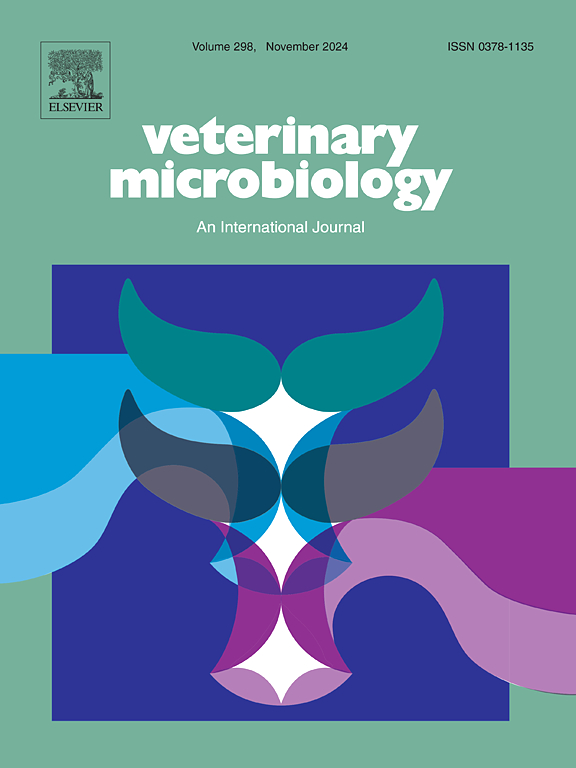Transcriptome profiling reveals a peculiarity of host immune responses to PA-X protein of H9N2 influenza A virus
IF 2.7
2区 农林科学
Q3 MICROBIOLOGY
引用次数: 0
Abstract
H9N2 avian influenza virus is widely prevalent among poultry populations around the word. PA-X protein of the virus is recognized as pivotal for pathogenicity and replication. However, the molecular mechanisms which remodel host immunity is unclear. In this study, we investigated the function of PA-X in H9N2 using a mutant PA-X recombinant virus(ΔPAX-rH9N2)which did not express PA-X protein. We found PA-X protein significantly impaired viral replication in chicken embryos and mammalian cell lines. Transcriptomic analysis further indicated that PA-X extensively modulates host responses. Through stringent screening, we identified 326 differentially expressed genes and found enriched in immune pathways, membrane systems, and metabolic processes. RT-qPCR confirmed that ΔPAX-rH9N2 infection suppressed the expression of inflammatory cytokines and inhibited type I interferon production via the TLR3–IRF7–IFNβ axis. Moreover, ΔPAX-rH9N2 impaired NLRP3 inflammasome activation, leading to reduced Caspase-1 cleavage, decreased GSDMD processing, and attenuated IL-1β maturation. Collectively, these findings demonstrate that the PA-X protein in H9N2 influenza A virus serves to balance host immune responses.
转录组分析揭示了宿主对H9N2甲型流感病毒PA-X蛋白免疫反应的特殊性
H9N2禽流感病毒在世界各地的家禽种群中广泛流行。病毒的PA-X蛋白被认为是致病性和复制的关键。然而,改造宿主免疫的分子机制尚不清楚。在这项研究中,我们使用不表达PA-X蛋白的突变PA-X重组病毒(ΔPAX-rH9N2)研究了PA-X在H9N2中的功能。我们发现PA-X蛋白显著地削弱了病毒在鸡胚胎和哺乳动物细胞系中的复制。转录组学分析进一步表明,PA-X广泛调节宿主反应。通过严格的筛选,我们确定了326个差异表达基因,并发现在免疫途径、膜系统和代谢过程中富集。RT-qPCR证实ΔPAX-rH9N2感染通过TLR3-IRF7-IFNβ轴抑制炎症细胞因子的表达,抑制I型干扰素的产生。此外,ΔPAX-rH9N2损伤了NLRP3炎性体的激活,导致Caspase-1切割减少,GSDMD加工减少,IL-1β成熟减弱。总的来说,这些发现表明H9N2甲型流感病毒中的PA-X蛋白可以平衡宿主的免疫反应。
本文章由计算机程序翻译,如有差异,请以英文原文为准。
求助全文
约1分钟内获得全文
求助全文
来源期刊

Veterinary microbiology
农林科学-兽医学
CiteScore
5.90
自引率
6.10%
发文量
221
审稿时长
52 days
期刊介绍:
Veterinary Microbiology is concerned with microbial (bacterial, fungal, viral) diseases of domesticated vertebrate animals (livestock, companion animals, fur-bearing animals, game, poultry, fish) that supply food, other useful products or companionship. In addition, Microbial diseases of wild animals living in captivity, or as members of the feral fauna will also be considered if the infections are of interest because of their interrelation with humans (zoonoses) and/or domestic animals. Studies of antimicrobial resistance are also included, provided that the results represent a substantial advance in knowledge. Authors are strongly encouraged to read - prior to submission - the Editorials (''Scope or cope'' and ''Scope or cope II'') published previously in the journal. The Editors reserve the right to suggest submission to another journal for those papers which they feel would be more appropriate for consideration by that journal.
Original research papers of high quality and novelty on aspects of control, host response, molecular biology, pathogenesis, prevention, and treatment of microbial diseases of animals are published. Papers dealing primarily with immunology, epidemiology, molecular biology and antiviral or microbial agents will only be considered if they demonstrate a clear impact on a disease. Papers focusing solely on diagnostic techniques (such as another PCR protocol or ELISA) will not be published - focus should be on a microorganism and not on a particular technique. Papers only reporting microbial sequences, transcriptomics data, or proteomics data will not be considered unless the results represent a substantial advance in knowledge.
Drug trial papers will be considered if they have general application or significance. Papers on the identification of microorganisms will also be considered, but detailed taxonomic studies do not fall within the scope of the journal. Case reports will not be published, unless they have general application or contain novel aspects. Papers of geographically limited interest, which repeat what had been established elsewhere will not be considered. The readership of the journal is global.
 求助内容:
求助内容: 应助结果提醒方式:
应助结果提醒方式:


